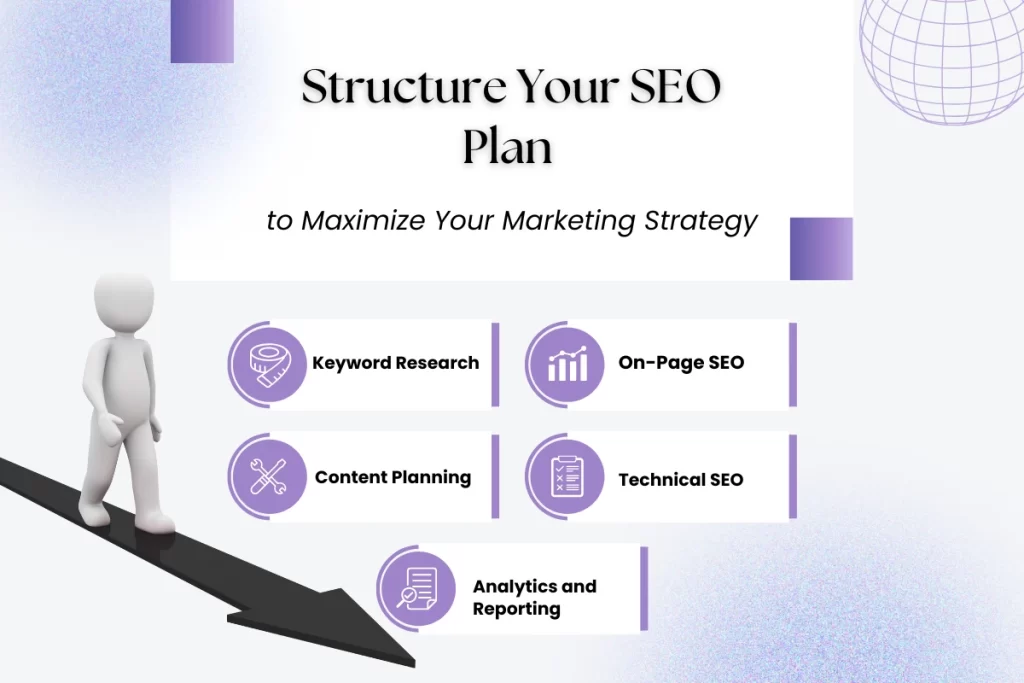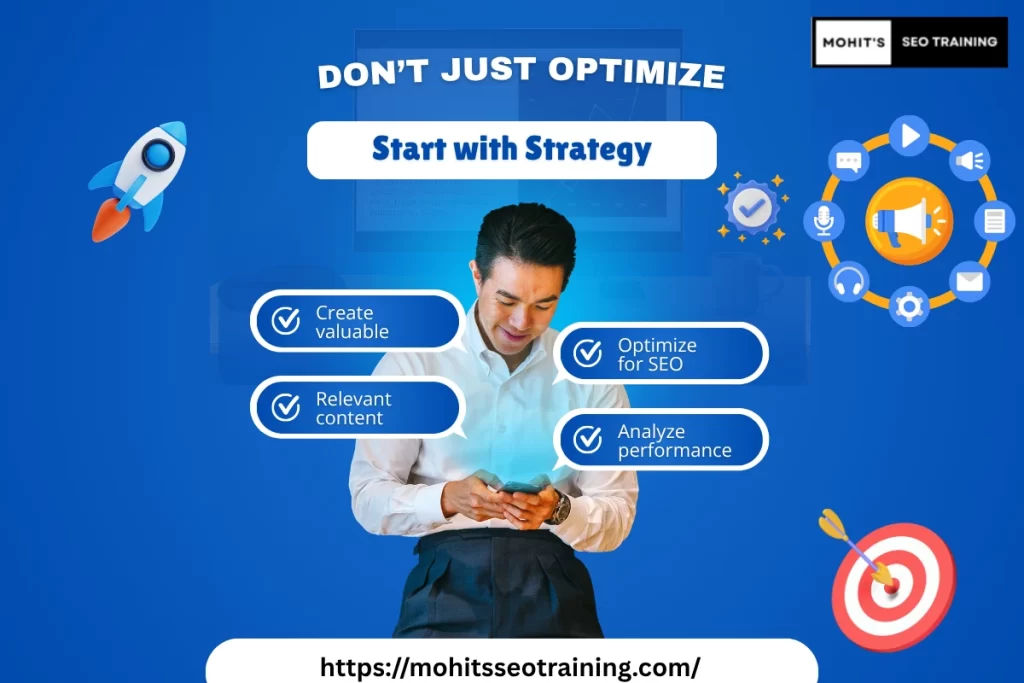Structured SEO Starts Here: What Should Be the First Step of Your Plan?
Imagine starting a journey without knowing your current location. Sounds reckless, right? That’s exactly what happens when you try to implement SEO without understanding where your website currently stands.
If you’re asking, “What should be the first step of a structured SEO plan?”—you’re already ahead of many. This blog breaks down the very first (and most important) step of building a results-driven SEO strategy. Whether you’re a student, an SEO manager, or a business owner trying to improve organic visibility, this guide is your launchpad.
Let’s build your SEO game plan the right way—starting at the source.
In this blog we are going to discuss the following points:
What Is a Structured SEO Plan?
What Should Be the First Step of Structured SEO Plan Answer?
What Is the First Step of SEO?
What Is the Role of Technical SEO in the Initial Plan?
When Should You Consider Updating Your SEO Plan?
What Is a Structured SEO Plan?
A structured SEO plan is a detailed, intentional, step-by-step plan to improve a website’s search visibility. A structured SEO plan is different from ad hoc or reactive programs in that it will allow for intentional timeframes for each step in research, technical SEO, content plan, link-building, performance review and to make adjustments.
Components of a Structured SEO Plan
| Phase | Focus Area | Key Activities |
| Audit & Research | Website health, User intent | Technical audit, Keyword & competitor research |
| On-Page Optimization | Content and metadata | Meta tags, headings, internal linking |
| Technical Improvements | Crawlability & UX | Site speed, mobile-friendliness, indexing |
| Content Strategy | Value-driven information | Blogs, service pages, landing page creation |
| Link Building | Authority development | Outreach, guest blogging, digital PR |
| Local SEO (if relevant) | Local visibility | GMB profile, reviews, NAP consistency |
| Analytics & Reporting | Progress tracking | GA4 setup, Search Console, KPI dashboards |
Example
Let’s say you run an eCommerce site selling fitness gear. A structured SEO plan would start by auditing your site to find technical issues like slow product pages or duplicate category content. Next, you’d identify that your audience often searches for terms like “best resistance bands for home workouts.” This insight leads you to optimize your product pages and publish a blog targeting that exact phrase. Your structured plan might include:
- Fixing slow-loading product pages
- Creating content clusters around fitness equipment guides
- Building backlinks from fitness forums or bloggers
In this case, SEO isn’t guesswork, it’s a step-by-step growth system.

What Should Be the First Step of Structured SEO Plan Answer?
The first step in any structured SEO plan is to perform a comprehensive audit of the website.
Think of this as your SEO health check. An audit helps you:
- Identify technical issues like crawl errors, site speed problems, and mobile-friendliness
- Assess on-page SEO elements like meta tags, header structure, and keyword placement
- Review content quality, keyword targeting, and internal linking
- Evaluate off-page signals such as backlinks and authority
“You can’t improve what you haven’t measured.”
A proper audit tells you exactly where your SEO stands and what needs fixing before building anything new.
Example
A SaaS startup notices its blog traffic is stagnant. An audit reveals multiple broken links, missing H1s, and pages competing for the same keyword. By addressing these issues first, the startup sees a 35% increase in organic visits within 60 days—without publishing new content.
What Is the First Step of SEO?
Beyond technical fixes, SEO success begins by understanding your audience and their search intent.
Before targeting any keywords, ask:
- Who are your ideal users?
- What questions are they asking Google?
- What words or phrases are they using?
- What kind of content currently ranks for those queries?
This alignment with search intent ensures you don’t just attract visitors—but the right visitors. Pairing your audit with intent research ensures every step you take is informed and strategic.
What Is the Role of Technical SEO in the Initial Plan?
Technical SEO will be the framework of your site’s discoverability.During the initial audit, pay close attention to:
1. Website Speed and Performance
Website speed isn’t just about user experience—it’s a direct ranking factor. Slow-loading pages can lead to higher bounce rates and lower crawl frequency.
- Optimize images (WebP format, lazy loading)
- Minify CSS, JavaScript, and HTML
- Implement server-side caching and CDN
- Reduce TTFB (Time to First Byte)
2. Mobile Responsiveness
Google’s mobile-first indexing means your mobile version is your primary site in their eyes.
- Use responsive design (no separate m-dot)
- Ensure tap targets and font sizes are mobile-friendly
- Test across multiple devices and screen sizes
- Prioritize mobile load speed (critical with INP in 2025)
3. Crawlability and Indexation Issues
Search engines must access and understand your content.
- Avoid orphan pages and noindexed important pages
- Eliminate crawl traps (e.g., infinite scroll, session IDs)
- Use canonical tags and hreflang correctly
- Fix 4xx and 5xx errors quickly
4. XML Sitemaps and Robots.txt Configuration
These files guide Google’s crawl behavior.
- Ensure XML sitemap is dynamic and updated
- Submit sitemap in Google Search Console
- Block non-essential paths in robots.txt (e.g., admin pages)
- Never block JavaScript or CSS files
5. Core Web Vitals (2025 Update)
Google’s latest updates highlight user experience metrics more than ever.
- LCP (Load Speed): Aim <2.5s
- CLS (Layout Stability): Aim <0.1
- INP (Interactivity): Aim <200ms – INP replaces FID in 2025
Optimize for responsive images, efficient fonts, and non-blocking JS to improve scores.
6. Log File Analysis (Log Details)
Analyzing server logs provides visibility into how bots behave.
- Track crawl budget and bot activity
- Identify ignored or under-crawled pages
- Detect render-blocking resources
- Validate coverage for priority URLs
7. Canonical Issues
Incorrect use of canonical tags leads to duplicate content and indexing errors.
- Use self-referencing canonicals
- Avoid inconsistent canonicals vs hreflang
- Monitor dynamically generated URLs and filters
- Audit canonical clusters in Search Console
8. Secure Experience (HTTPS & Trust Signals)
Security plays a direct role in rankings and user trust.
- Ensure full HTTPS with valid SSL certificate
- Avoid mixed content errors
- Use HSTS headers
- Redirect HTTP to HTTPS using 301s
9. Schema Markup Issues
Structured data helps Google understand and enhance your content.
- Add relevant schemas: FAQ, Product, Review, How-To, Breadcrumb
- Avoid errors or incomplete fields
- Test using Rich Results Test and Schema Validator
- Monitor warnings in Search Console’s enhancements tab
10. Website Architecture
Clean architecture improves crawl efficiency, link equity flow, and UX.
- Keep pages within 3-click depth
- Use clear, descriptive URLs
- Implement breadcrumb navigation
- Avoid deep nesting and orphan pages
- Align internal linking with topic clusters
Example
A digital agency client’s homepage wasn’t indexed. A technical audit uncovered a rogue “noindex” tag. Once removed, the homepage began ranking for branded keywords within days.
How to Align SEO Goals with Business Objectives
Your SEO plan should not work in isolation. Align it with:
- Revenue goals
- Customer acquisition targets
- Brand visibility KPIs
Whether your goal is more leads, eCommerce sales, or newsletter signups, your SEO activities—from keyword research to content creation—should be aligned with outcomes that impact the business.
When Should You Consider Updating Your SEO Plan?
SEO isn’t one-and-done. You should revisit your strategy when:
- Google releases a core algorithm update
- Rankings or traffic suddenly decline
- You redesign or restructure your site
- You introduce new products, services, or markets
- Competitors begin to outrank you
- You are not getting the desired results
- No revenue from the content publsihed
Even without a trigger, set a calendar reminder to review your SEO plan every 3 to 6 months.
How to Structure Your SEO Plan After the First Step
Once your audit and user research are done, follow this roadmap:
- Keyword Research – Map intent-based keywords to key pages
- On-Page SEO – Optimize titles, meta descriptions, URLs, and internal links
- Content Planning – Create, update, or merge content based on gaps and user needs
- Technical SEO – Improve speed, fix indexing issues, enable schema markup
- Link Building – Earn authoritative backlinks through outreach and PR
- Local SEO – If applicable, optimize GMB, local citations, and map listings
- Analytics and Reporting – Set KPIs, track rankings, traffic, and conversions
How to Prioritize SEO Tasks Post-Audit
After completing your audit, break tasks into:
- High priority fixes (errors, broken links, index issues)
- Medium priority (on-page tweaks, metadata, UX issues)
- Long-term improvements (content strategy, authority building)
This triage approach helps avoid overwhelm and ensures consistent progress.
Mistakes to Avoid When Starting an SEO Plan
- Ignoring your current site health and diving into new content
- Choosing keywords before knowing your audience
- Using outdated tools or tactics
- Optimizing pages with no search volume
- Not collaborating with developers, writers, or designers
Avoiding these traps will save you time, money, and frustration down the line.
Final Thoughts
The most successful SEO campaigns don’t start with keywords—they start with clarity.
So, what should be the first step of a structured SEO plan? A full diagnosis of where your site stands, who your audience is, and what they need. From there, every SEO tactic you apply will be sharper, faster, and more effective.
Structure isn’t just a buzzword it’s your SEO strategy’s backbone.
Start smart. Start strategic. Start with a plan that’s built to grow.
Related Article
FAQs
What should be the first step of a structured SEO plan?
Begin with a full audit of your website and align your strategy with user search intent.
Why is an SEO audit essential before anything else?
It gives you a baseline to measure progress, uncovers technical and content issues, and highlights key opportunities.
How often should I revisit my SEO plan?
Every 3–6 months or after any major update, redesign, or dip in performance.
What’s more important technical or content fixes?
Both matter, but the priority depends on your audit findings. Start with what impacts crawlability, UX, and ranking signals first.
Can I rank without a structured plan?
You might get lucky, but consistent, scalable SEO growth requires structure, not guesswork.
Mohit Verma I am an experienced professional with 9+ years of experience in Search Engine Optimization. I am on a mission to provide industry focused job oriented SEO so the students/mentees can get their dream SEO job and and start working from day 1.
